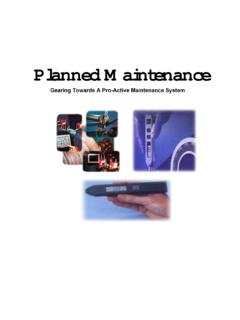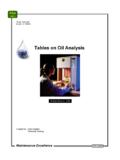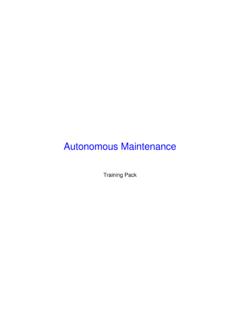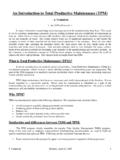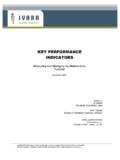Transcription of Total Productive Maintenance - RSA Reliability and ...
1 1 Total Productive Maintenance 1 Table of Contents: 1. Introduction to TPM ..2 2. History of TPM ..2 The spread of TPM ..4 Why TPM is so 3. TPM Eight Pillars ..5 Training and Autonomous Maintenance ..7 The Need for Autonomous 8 Seven Steps of Autonomous Maintenance ..9 Planned Maintenance ..14 Planned Maintenance Defined ..15 What Planned Maintenance Pillar Includes ..16 What Planned Maintenance Pillar Want to Achieve ..16 Introduction to Planned Maintenance ..16 Planned Maintenance in 4 Phases ..17 Focused Improvement (Kobe s-kaizen) ..19 Step by step procedure for Focused Improvement ..20 Office / Administrative TPM ..21 The Role of Administrative TPM ..22 Quality Maintenance ..22 who is Responsible for Quality Maintenance ..24 Early Equipment MP Design and its Importance ..25 Environmental, Health and Safety.
2 25 Environment and Safety Management ..25 4. Equipment Six Big Losses .. 26 Breakdown Set-up loss ..27 Tips on Shortening Internal Setup ..27 Eliminating Small Losses in Setup ..28 The SMED System .. 28 Traditional Setup Approach ..28 Technique to Implement SMED .. 29 Effect of SMED Technique .. 30 Idling and Minor stoppages ..30 Design Speed Loss ..31 Start-Up Loss ..31 Defect and Rework Losses ..32 5. Overall Equipment Effectiveness ..33 6. TPM 12 Developmental Steps ..34 7. TPM Case Study ..42 8. Pitfalls of TPM ..45 9. Lessons on TPM..47 10. References ..49 21. Introduction to TPM: In today s global economy, the survival of companies depends on their ability to rapidly innovate and improve. As a result, an increasing search is on for methods and processes that drive improvements in quality, costs and productivity. In today s fast changing marketplace, slow, steady improvements in manufacturing operations will not guarantee profitability or survival.
3 Companies must improve at a faster rate than their competition if they are to become or remain leaders in their industry. Western products, practices and methods were long considered the best in the world. This perception is constantly changing as a result of new competition and economic pressures. Arrogance or self assurance has devastated specific sectors of our manufacturing base. For example, the Japanese now own the consumer electronics industry. Changes in the automotive industry are well documented, and for the first time Western dominated industry such as computers and aviation are facing serious challenges by foreign competitors. Other companies and cultures have proven they can compete successfully in the world marketplace with western manufacturing. To confront this challenge, enlightened company leaders are benchmarking their organizations performance and improvement processes against domestic and international competitors.
4 They are adopting and adapting best in class: manufacturing practices and improvement processes. As part of these benchmarking efforts Total Productive Maintenance (TPM) has been identified as a best in class manufacturing improvement process. Moreover cultural differences in both Japanese and Western countries can alter implementation strategies. TPM is a complex. Long term process which must be sold to the workforce as a legitimate improvement methodology. A sales pitch is created is created more easily for single homogeneous market segment than for a large diversified audience. For TPM to succeed in any industry, both management and the workforce must address issues strategically while operating in an environment of trust and organization. The improvement process must be recognized as benefiting both the company and the workers. The ultimate responsibility for success or failure of the TPM process rest more with management than the plant floor employees.
5 2. History of TPM: The term Total Productive Maintenance was first used in the late 1960 s by Nipponese, a supplier of electrical parts to Toyota. At the Time it was a slogan for their plant improvement theme Productivity Maintenance with Total employee participation. In 1971, Nipponese received the Distinguished Plant Award (The PM Prize) from Japan Institute of Plant Maintenance (JIPM). Nipponese was the first plant to receive the award as a result of implementing TPM and this marked the beginning of Jim s association with the improvement methodology. Eventually, Seiichi Nakajima, a vice chairman of JIOPM, became known as the father of TPM, since he provided implementation support to hundreds of plants, mostly in Japan. Nakajima describes TPM as Productive Maintenance carried out by all employees through small group activities. He considers it an equal partner to Total Quality Management in the attainment of world class manufacturing.
6 According to TPM principles, the responsibility for optimizing equipment lies not just with the Maintenance department but with all plant personnel. Although many definitions for TPM had been gathered, for the purpose of this report, we shall define TPM as follows 3 TPM is a plant improvement methodology which enables continuous and rapid improve-ment of the manufacturing process through the use of employee involvement, employee empowerment and closed looped measurements of results. TPM is a method for bringing about change. It is a set of structured activities that can lead to improved management of plant assets when properly performed by individuals and teams. The culture of a plant does not evolved solely from TPM but may also be a reflection of other improvement processes that are underway such as TQM, Six Sigma, Lean, Kaizen, Root Cause Analysis etc., A critical aspect of TPM is that improvements should be rapid as well as continuous.
7 Today s marketplace requires new paradigms. The story between the race of the hare and tortoise had to be modified. Current and future winners in industry will combine the quickness and speed of the rabbit with the perseverance of the tortoise. To attain or maintain a leadership at a rate that is much faster than their competition. Performance target must be always be dynamic, not static. If a company sets goals and measures to reach performance levels of their best in class competitor in two years, they will lag behind, since their competition will have improved over that same period of time. To be the best in class, a company must leap-frog its competition by setting goals beyond where their competition is projected to be. Likewise, in TPM, employee involvement is a necessary part of the TPM process. The goal is to tap into the expertise and creative capabilities of the entire plant or facility through the use of small group activities.
8 The Total involvement of plant personnel generates pride and job satisfaction as well as financial gains for the organization. Despite the advent of self managing teams employee involvement is still new and starting in most western countries. TPM requires employees to take a more active role in decision making and to accept responsibility for the plant and its physical condition. They have a heightened role in defining their job content, along with work systems and procedures. The intent of TPM is that each employee must takes pride in their equipment and all efforts must be directed the plant s objectives. For example, JIPM reco-mmends that management adopt the theme of My Plant to increase the level of autonomous Maintenance . Western plants typically emphasize performance measures that are related to production and financial results. Numbers are tracked, reported by accountants and made available to selected members of the organization.
9 There are two problems associated with classical results measurements. First, the results are not reported to all involved parties and secondly, results that are reported do not effectively measure performance. In TPM, the plant establishes the key performance indicators that measure performance relative to plant goals and objectives. These key performance indicators measure results in areas over which the plant has control. Typically, they include availability, quality, productivity and cost efficiency as well as measures of the effectiveness of the improvement process itself. The indicators are reported in a closed-loop manner back to the individuals who have the power to impact them. Hence, information is passed on to everyone including the shop floor people. Figure 1: Seiichi Nakajima, Founder of TPM 4 The Spread of TPM As said that TPM took root in the automobile industry and rapidly became part of the corporate culture in companies such as Toyota, Nissan and Mazda as well as their suppliers such as Nippondenso.
10 It has also been introduced by other industries such as consumers, appliances, microelectronics, machine tools, plastics and many others. Having introduced Preventive Maintenance , the process industries then began to implement TPM. An increasing number of process plants have introduced TPM over the past few years in industries such as food, rubber, oil refining, chemical, pharmaceuticals, gas, cement, papermaking, iron, steel and printing. Initially, corporate TPM activities were limited to departments directly involved with equipment such as production, however administrative and support departments while actively supporting TPM in production are now applying TPM to enhance the effectiveness of their own activities. TPM improvement methods and activities are also being adopted in product development and sales department. This last trend underlines the increasing tendency to consider production processes and equipment at the product development stage in an effort to simplify production, improve quality assurance and enhance and reduce the start-up period for new production.
